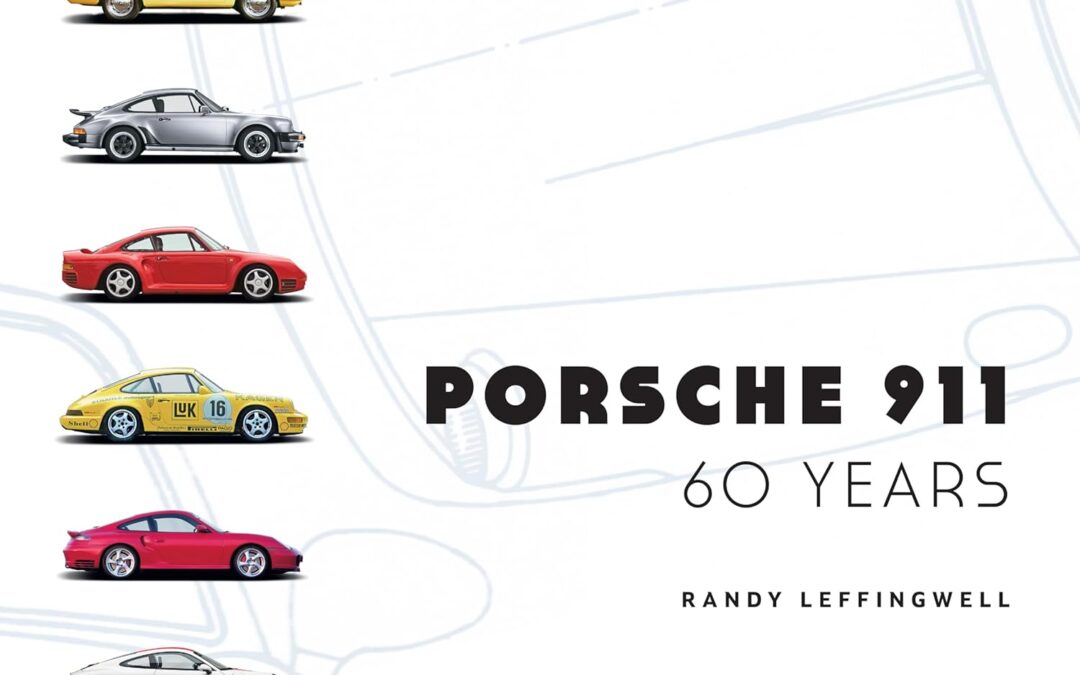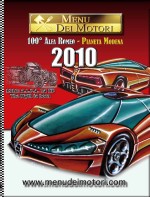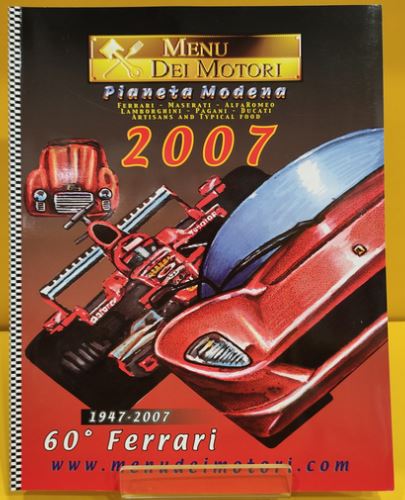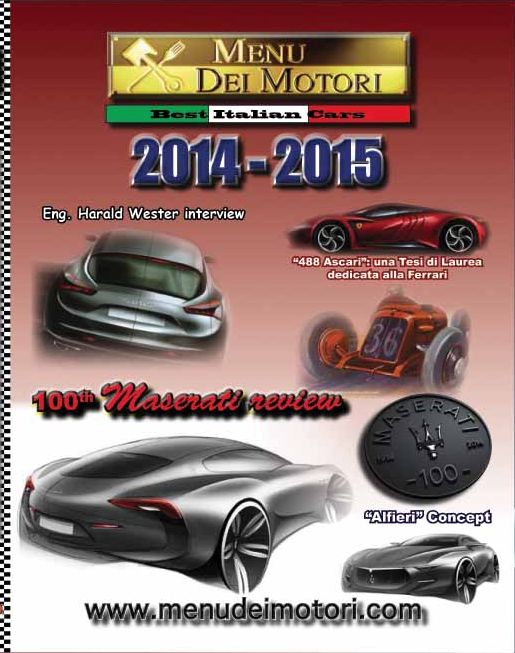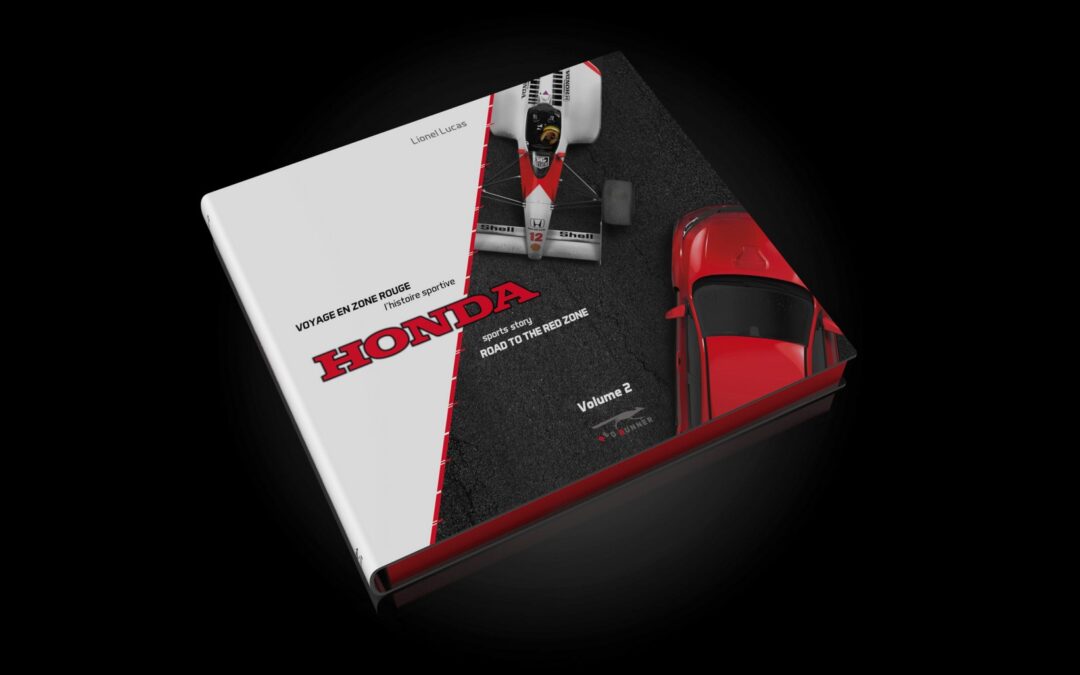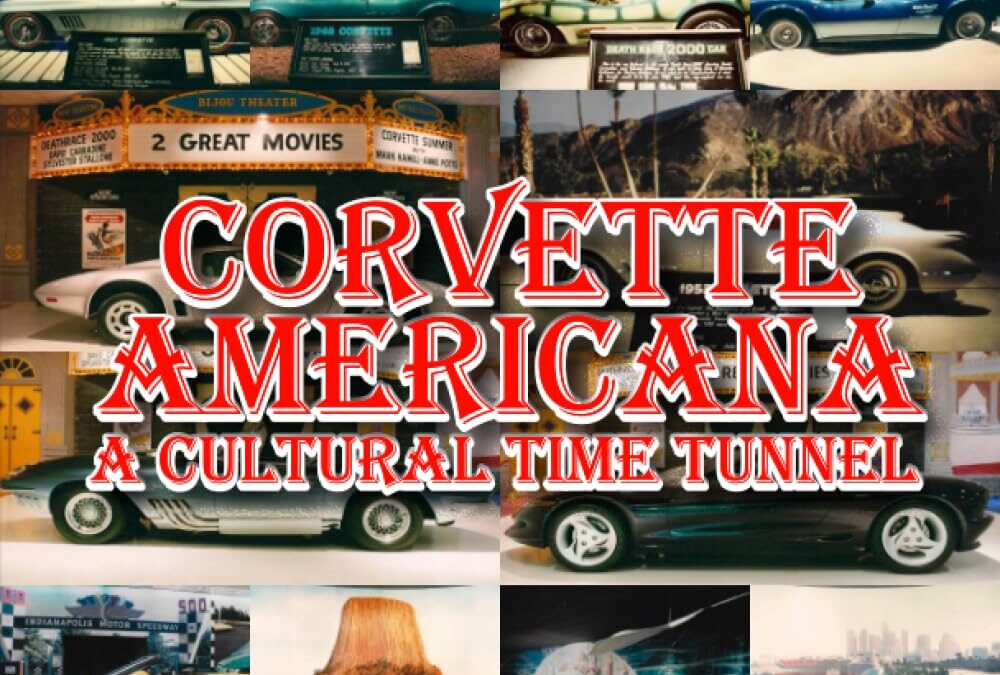
Allen Schery is perhaps the first Anthropologist to have designed a Car Museum. Prior to his design we generally only see rows of cars with small signs. Allen’s unique idea was to place each car in a set featuring a giant 15 x 30-foot photo mural that utilized a curved dioramic wall to give a 3-D effect incorporating a symbol of American Culture as a backdrop. Allen then took several trips around America logging in some 20,000 miles of trips procuring pictures of Mt. Rushmore, Niagara Falls, The Golden Gate Bridge, the Alamo, and other well-known American Landmarks. Each set featured real earth scenes and stage lighting. The Corvette was used as a time-coordinated symbol of American Culture to anchor the exhibit. He then theorized that as the original owner of each car placed the key in the ignition he was surrounded by the culture of a bygone year of Americana. He sought to recreate the sights. sounds and memories of that bygone culture by using the music, television, and movie snippets of that year along with slides of news events and time-coordinated artifacts. The Museum won many awards as well as being chosen as one of the ten best museums in New York State. Each room became a time capsule to that year with the entire museum a giant time tunnel.
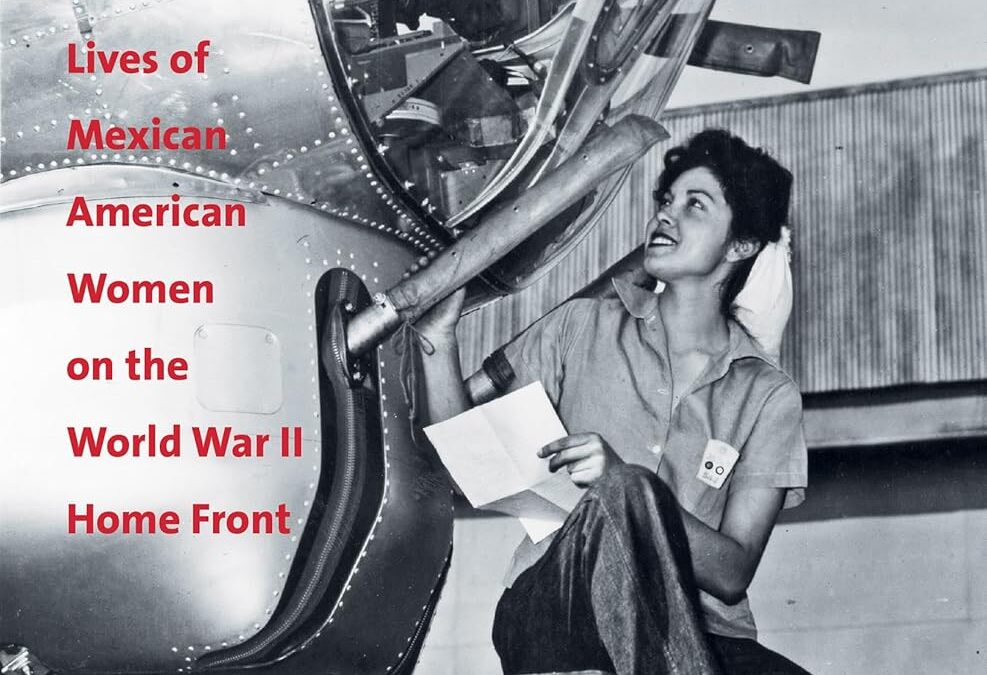
During World War II, unprecedented employment avenues opened up for women and minorities in U.S. defense industries at the same time that massive population shifts and the war challenged Americans to rethink notions of race. At this extraordinary historical moment, Mexican American women found new means to exercise control over their lives in the home, workplace, and nation. In From Coveralls to Zoot Suits, Elizabeth R. Escobedo explores how, as war workers and volunteers, dance hostesses and zoot suiters, respectable young ladies and rebellious daughters, these young women used wartime conditions to serve the United States in its time of need and to pursue their own desires.
But even after the war, as Escobedo shows, Mexican American women had to continue challenging workplace inequities and confronting family and communal resistance to their broadening public presence. Highlighting seldom heard voices of the “Greatest Generation,” Escobedo examines these contradictions within Mexican families and their communities, exploring the impact of youth culture, outside employment, and family relations on the lives of women whose home-front experiences and everyday life choices would fundamentally alter the history of a generation.
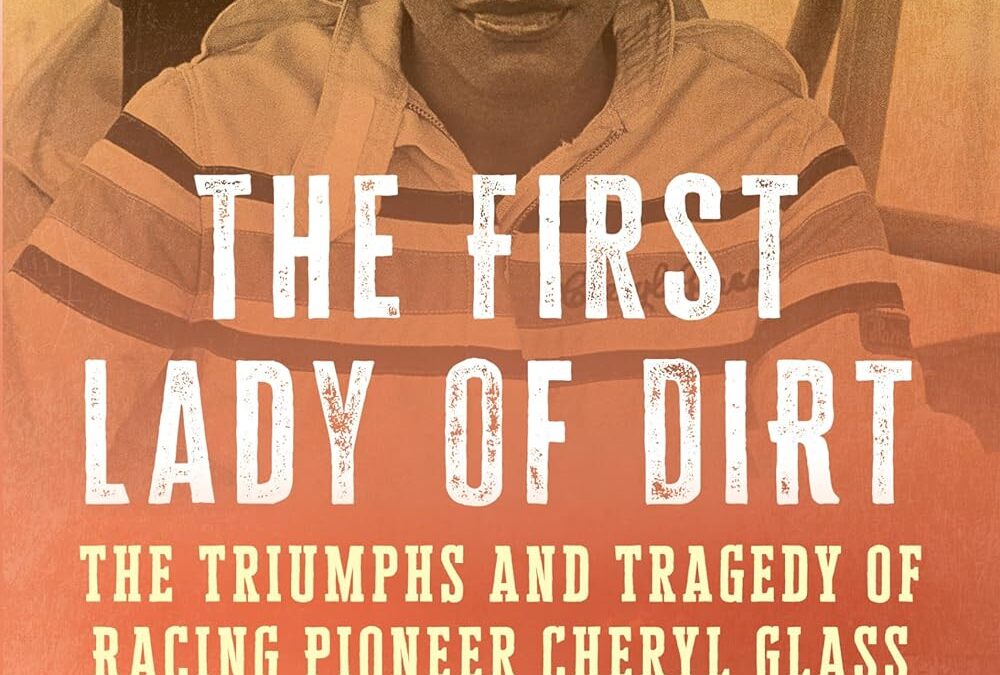
The incredible, little-known story of the first successful Black woman in the sport of auto racing in the United States.
Early in her career, Cheryl Glass looked like a lock to become the first Black woman to compete in the Indianapolis 500. From racing quarter midget cars at ten years old to Indy Lights in her twenties, Cheryl was on her way towards a winning career in auto racing.
In The First Lady of Dirt: The Triumphs and Tragedy of Racing Pioneer Cheryl Glass, Bill Poehler tells Cheryl’s full story for the first time. He recounts how Cheryl rapidly became the first successful Black woman in the sport, yet frequently encountered racist and sexist taunts from other drivers and fans throughout her career. While appearing to have it all—talent, ambition, looks—she faced many challenges on and off the track and her life soon spun out of control.
Featuring exclusive interviews with Cheryl’s mother, friends, and competitors, The First Lady of Dirt takes you behind the scenes and in the driver’s seat of Cheryl’s life. Poehler, an amateur racer himself, places the reader at the track, smelling the dirt and fumes, hearing the roaring engines and crashing metal, and feeling Cheryl’s joy and pain. It’s the inspiring story of a racing pioneer and a tragic tale of the pressures that are often hidden from public view until it’s too late.

Trophies and Scars is the profoundly personal, sincere, and remarkably revealing story of the life and times of NASCAR Hall of Famer Ray Evernham. A son of the Jersey Shore, Evernham dedicated his life to fulfilling his boyhood dream of becoming a professional race car driver.
By age eighteen, he was banging fenders with good success on the Northeast short track circuit. When his dreams of becoming an Indy car sensation literally crashed and burned, he turned to Roger Penske’s International Race of Champions (IROC), before another brutal crash forced him to give up his Indy dream for good.
It was time to change careers.
As a leader of a race team on the technical rather than the driving side, he discovered new skills critical to building successful racing organizations. A brief, ill-fated, and downright volatile stint on Alan Kulwicki’s crew, turned into a “right place at the right time” scenario, sparking a seminal partnership with racing phenom Jeff Gordon. They would prove to be one of the most potent racing duos in history.
Evernham shares previously untold tales of how the duo led the No. 24 team to three championships in four seasons (1995, 1997, 1998) and a series-leading forty-seven wins, revealing in candid detail how and why their storied relationship came to an end.
The book also details Evernham’s time spearheading the return of Dodge to NASCAR, building Evernham Motorsports into one of the most successful NASCAR teams, as well as his transformation into a TV personality with roles as a NASCAR analyst for SPEED, ESPN, ABC, FOX, and NBC and as host to his own TV series, AmeriCarna, on the Velocity channel.
Woven throughout all these stories recounting the many twists and turns of his life, he reveals how he buried himself in work to cope with his personal challenges, such as his son Ray J.’s battle with leukemia and later autism diagnosis. Many of these painful challenges ultimately brought rich rewards, such as the formation of the Evernham Family Racing for a Reason Foundation, funding for IGNITE, education and training programs for young adults with high-functioning autism or Asperger’s syndrome, his loving marriage to Erin, and the birth of their daughter Caite.
You needn’t be a racing fan to appreciate Evernham’s inspiring journey of tireless persistence, radical determination, steadfast leadership, and fearless reinvention. For as he believes, a life lived to the fullest is packed with trophies–and scars.
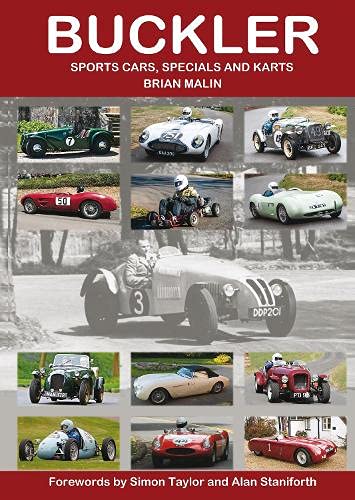
Although they were born 18 years apart, Derek Buckler and Colin Chapman were contemporaries when it came to designing and building ground-breaking sports cars in the late 1940s and early ’50s. They had much in common. Both were innovators, especially in areas of chassis design and improving the handling characteristics of their cars. Both founded successful companies and both died relatively young, Chapman in December, 1982, at the age of 54, and Buckler in 1964 at just 53 years of age. Yet, while Chapman’s Lotus went on to achieve worldwide fame, the name Buckler remains comparatively little known.
Special building was popular in the 1950s, mostly using ‘donor’ chassis from Austin 7 or Ford or simple ‘ladder’ frames but Buckler offered a multi-tubular space frame which was both stronger and lighter and, moreover, available in different models to suit different applications. He was also always ready to adapt his products to his customers’ requirements. In all of this, Buckler’s aim was to provide the impecunious enthusiast with a versatile sporting vehicle which could be used as daily transport during the week and, at weekends, in a wide range of motor sporting events from trials and driving tests to out and out racing. Often, however, the resulting Special would carry a name that concealed the Buckler contribution and a major part of the significance of Malin’s book and the vast amount of painstaking research put into it by its author is that much of that contribution is now revealed.
Buckler also, of course, made a range of complete cars starting with the versatile Mk5 and 6 and going on to encompass DD1 and DD2 with De Dion rear ends and the BB100 with backbone chassis introduced considerably before Lotus’s Elan and their other similarly based models. When karting became popular in the early 1960s, Buckler’s space frame technology found another application for which it was ideal and it became a major player in this burgeoning branch of motor sport. Buckler was also successful with its range of accessories including engine and transmission components and most notably its much admired close-ratio gears.
Brian Malin, the author, first owned a Buckler car in the 1970s and today competes in his Mk 5 in hill climbs and other events. He is an active member of the Buckler Register as well as the British Historic Kart Club and is often to be seen racing or demonstrating his Buckler kart so he is well placed to compile this comprehensive history of all things Buckler. It was first made available in loose-leaf form as long ago as 1990 but this is its first publication as a fully-fledged book, revised, updated and with additional material. Chassis design guru – and Buckler owner – the late Alan Staniforth provided the original foreword and this has been updated and included along with a new foreword by commentator and doyen of motor sport journalists, Simon Taylor.
The fourteen chapters begin with ‘Buckler and the Company’, cover the production and racing cars with some individual histories, the Buckler accessories including one chapter on the badges alone, overseas distribution – New Zealand was a particularly strong market for Buckler – and a fascinating section on the car advertisements before going on to cover the kart story in similar detail. The same number of appendices include reproductions of road tests, articles written by Derek Buckler, specifications of close-ratio gears and Buckler-tuned Ford engines, kart track tests and even one on Buckler letterheads. Malin’s work is truly encyclopaedic and therefore remarkable value for money not just as a reference on the Buckler marque but for its entertaining insight into the world of amateur motor sport of its time. The hundreds of illustrations range from reproductions of high quality contemporary and recent photographs to some admittedly lower quality originals, some of them obviously retouched to improve clarity, whose inclusion is well justified for their essential contribution to the Buckler story.
Brian Malin is to be congratulated for his perseverance in finally bringing to publication a book which is, to all intents and purposes, the full Buckler story.

The definitive illustrated history of the exotic sports cars and supercars of McLaren Automotive.
When the McLaren Formula 1 team set up McLaren Cars and launched the revolutionary, iconic F1 road car in 1992, it turned the supercar world upside down. McLaren wouldn’t make another road car itself until it formed McLaren Automotive in 2010. It was set up with the vision not just to rival the established companies in the sports and supercar marketplace, but to disrupt and to constantly innovate in its pursuit of performance.
Readers will learn the following:
• Upstart company McLaren Automotive applied Formula 1 engineering expertise, innovation, and radical thinking to create cars that quickly became benchmarks for performance, ride, and handling against long-established supercar manufacturers such as Ferrari, Lamborghini, and Porsche.
• Unparalleled insight from the designers, engineers, aerodynamicists, and test drivers who create McLaren Automotive’s cars, with modern, independent insight from test drives by automotive journalists and the author
• Detailed technical insight, background stories, and data to the creation, development, and manufacture of all of McLaren Automotive’s sensational cars, with the text supported by comprehensive data tables and illustrated by images from a team of world-renowned automotive photographers
This book contains incredible insight and detail from access to McLaren’s press archives, as well as interviews with countless key people within the company. The first and only book dedicated entirely to McLaren’s incredible road cars, this is the complete history of a fascinating automotive brand that’s challenged the establishment.

A nostalgic and celebratory look back at one hundred years of passenger flight, featuring full-color reproductions of route maps and posters from the world’s most iconic airlines, from the author of bestselling cult classic Transit Maps of the World.
In this gorgeously illustrated collection of airline route maps, Mark Ovenden and Maxwell Roberts look to the skies and transport readers to another time. Hundreds of images span a century of passenger flight, from the rudimentary trajectory of routes to the most intricately detailed birds-eye views of the land to be flown over. Advertisements for the first scheduled commercial passenger flights featured only a few destinations, with stunning views of the countryside and graphics of biplanes. As aviation took off, speed and mileage were trumpeted on bold posters featuring busy routes. Major airlines produced highly stylized illustrations of their global presence, establishing now-classic brands. With trendy and forward-looking designs, cartographers celebrated the coming together of different cultures and made the earth look ever smaller.
Eventually, fleets got bigger and routes multiplied, and graphic designers have found creative new ways to display huge amounts of information. Airline hubs bring their own cultural mark and advertise their plentiful destination options. Innovative maps depict our busy world with webs of overlapping routes and networks of low-cost city-to-city hopping. But though flying has become more commonplace, Ovenden and Roberts remind us that early air travel was a glamorous affair for good reason. Airline Maps is a celebration of graphic design, cartographic skills and clever marketing, and a visual feast that reminds us to enjoy the journey as much as the destination.
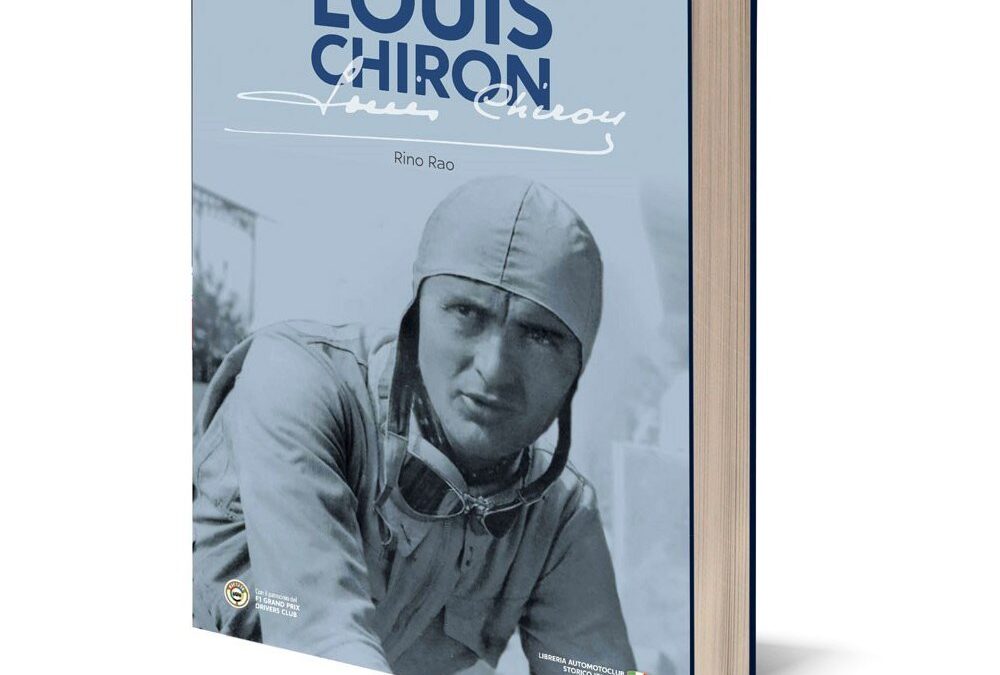
After the previous biographies “Giuseppe Campari – El Negher” and “Rudolf Caracciola – Una Vita per le Corse”, with this publication dedicated to Louis Chiron, the undisputed champion of Bugatti from Monaco and one of the greatest on the motorsport scene, Rino Rao completes the trilogy designed to provide motorsport enthusiasts with a history of Alfa Romeo, Mercedes and Bugatti for which they were respectively accredited testimonials: manufacturers that dominated the golden era of racing in the 1920s and 1930s.
The author has not neglected to place the sporting events in the broader historical context and customs in which they took place. The text, also prepared for quick reference through the analytical index and based on patient historic research, flows with images that make it possible, for the less attentive reader, to follow the course of events.

The story of a boy with a big four-wheel dream
There are men who fall in love with a dream when they are young and do everything they can to make it come true. Romano Artioli is an entrepreneur pursuing his desire to revive the world’s most prestigious automobile brand, Bugatti. With passion and dedication, he achieves this goal. Born in Mantua, birthplace of Nuvolari, the most famous race car driver of all time, Romano opens his first auto service centre in Bolzano at the age of eighteen, buys a hydraulic test bench and begins overhauling engines, immediately demonstrating great skill.
And he founds dealerships, imports cars and becomes president of the local automobile club. He understands the importance of going all out to meet the demands of his customers, who become his friends and help him sell cars.
He convinces Enzo Ferrari to entrust him with management of the brand not only in the Triveneto, but in southern Germany as well.
After amassing experience for years travelling the world, it’s time for him to make his boyhood dream come true: he charms the French government and arranges for the sale of the Bugatti brand.
Then, having been abruptly prevented from selecting a powerful partner among the many who were interested in developing Bugatti and ensuring its future as an independent brand, he acquires the crisis-ridden Lotus Group and rapidly restores it to its former grandeur.
There, he introduces new models with great success, such as the special Lotus Elise, named after Romano’s young granddaughter.
Exploiting the unique untapped potential of his technicians, who work with passion and total commitment. In the mid-nineties, the Bugatti EB 112 is named “the world’s most beautiful sedan”.
But as in a classic thriller, just when everything seems to have turned out right comes the sneaky and unexpected twist that changes everything. With endless twists and turns and a long line of bankers’ traps, lawyers’ scams and ravenous businessmen, Bugatti & Lotus Thriller tells the story of a great dream of genius and creativity that stirs passion in every petrolhead the world over.

#1 SUNDAY TIMES BESTSELLER • A high-octane, no-holds-barred account of a year inside Formula 1 from Haas team principal Guenther Steiner, star of Drive to Survive, one of the most successful Netflix series of all time
“People talk about football managers being under pressure. Trust me, that’s nothing. Pressure is watching one of your drivers hit a barrier at 190mph and exploding before your eyes…”
In Surviving to Drive, Haas team principal Guenther Steiner brings readers inside his Formula 1 team for the entirety of the 2022 season, giving an unobstructed view of what really takes place behind the scenes. Through this unique lens, Steiner guides readers on the thrilling rollercoaster of life at the heart of high-stakes motor racing. Packed full of twists and turns, from pre-season preparations to hiring and firing drivers, from the design, launch, and testing of a car to the race calendar itself–Surviving to Drive is the first time that an Formula 1 team has allowed an acting team principal to tell the full story of a whole season.
Uncompromising and searingly honest, told in Steiner’s inimitable style, Surviving to Drive is a fascinating and hugely entertaining account of the realities of running a Formula 1 team.
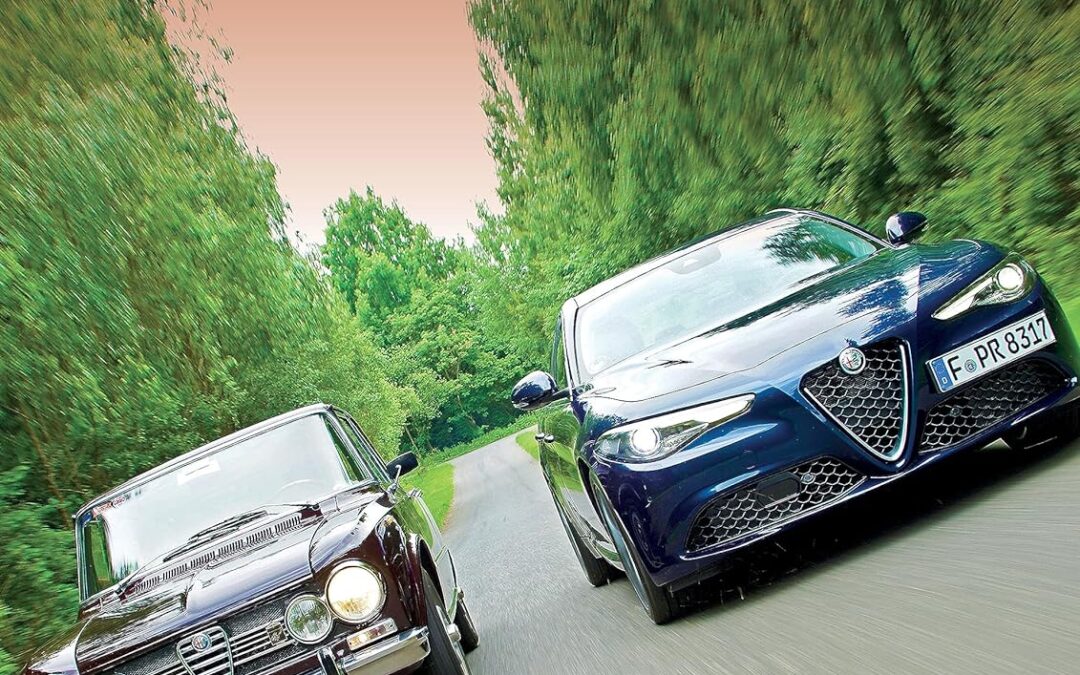
A complete history of 110 years of Alfa Romeo, the cars, the people, the racing, and the heritage.
For more than 110 years, Alfa Romeo has set the standard for elegant, sophisticated, and racy Italian automobiles. The first Alfa Romeo, the Tipo 24HP, rolled off the line in 1910 and paved the way for such classic and well-known models as the Tipo 33 Stradale, Guilia, Giulietta, Alfasud, Alfetta, and Stelvio—Alfa Romeo’s first SUV. And this comprehensive book covers them all and much more.
Automotive writer and Alfa Romeo buff Christian Schön celebrates the 110th anniversary of Alfa Romeo by taking a deep dive into the people, places, races, and especially the cars that are part of Alfa Romeo’s rich history and heritage. The book includes
• a thorough timeline of all the important events and milestones in Alfa Romeo’s 110-year history, 1910–2020;
• special sections on Alfa Romeo’s auto designs, engines, technology, concept cars, factories, and advertising, as well as the Alfa Romeo Museum in Milan and the key personnel responsible for Alfa Romeo’s rise to the top;
• an in-depth look at Alfa Romeo’s racing history, including five world championship titles, a dozen European championships, 11 victories in the legendary Mille Miglia endurance race, and a victory in the German Touring Car Championship (DTM); and
• exciting “behind the scenes” stories and more than 350 color and black-and-white images.
Anyone with a passion for Alfa Romeo—or automotive history, design, and racing in general—will find excitement in these pages. The book is a must-have for any automotive library.
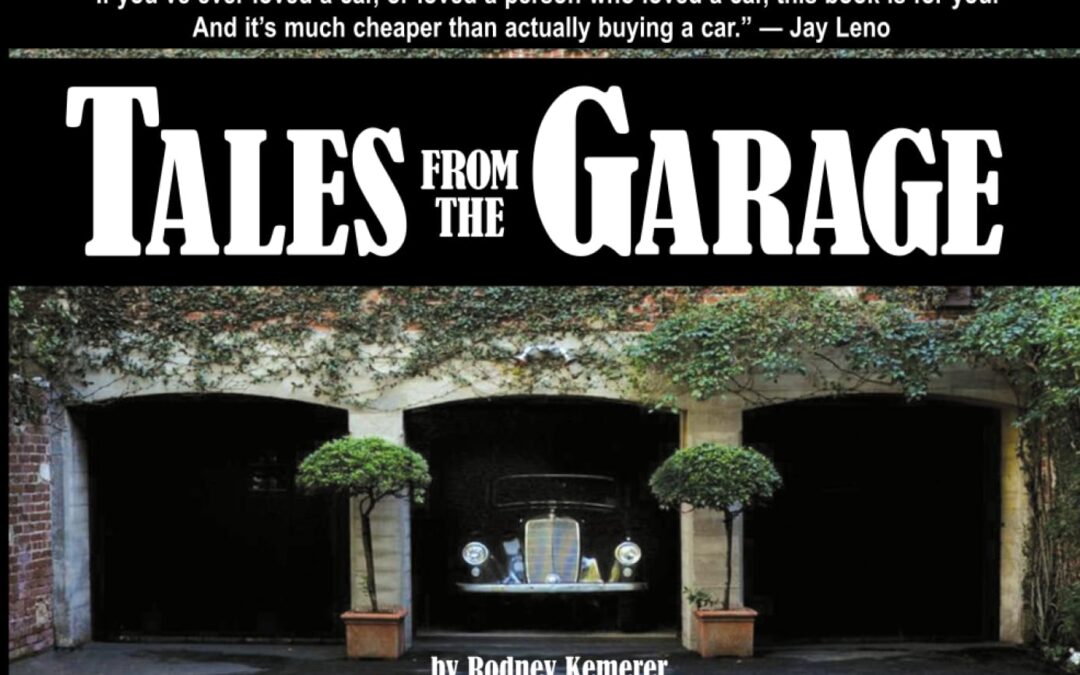
Rodney Kemerer’s Tales From the Garage, designed with the look and feel of an automotive owner’s manual, is far more than just a “car book.” As car enthusiasts Jay Leno and Wall Street Journal columnist Dan Neil have observed, Rodney’s warm and personal tales resonate deeply because everyone has a car story to tell, even if the car is just a springboard for a memory of a certain person or a certain place or even a certain feeling. These thirty stories, originating as essays in a host of publications and now reformatted with entirely new and colorful artwork, are filled with familiar moments that chronicle everything from finding just the right car for your wife (She wants a what? Really? What’s wrong with her?), to an ancient St. Christopher medal hiding at the back of a glove box, to a father’s deathbed pronouncement: “I should have bought Cadillacs.”
Author Rodney Kemerer understands that car stories can be the gateway to every aspect of our lives. His heartfelt book – half memoir, half the memories of others – is truly a pop culture snapshot of modern society told through the lens of the automobile. These tales might appear to be about cars, but they are also tales of an American life and the many objects that embody and reflect it. So pull up a chair and your favorite beverage as you meet a new friend who is happy to share his favorite Tales From the Garage.
“If you’ve ever loved a car, or loved a person who loved a car, this book is for you. And it’s much cheaper than actually buying a car.” – Jay Leno
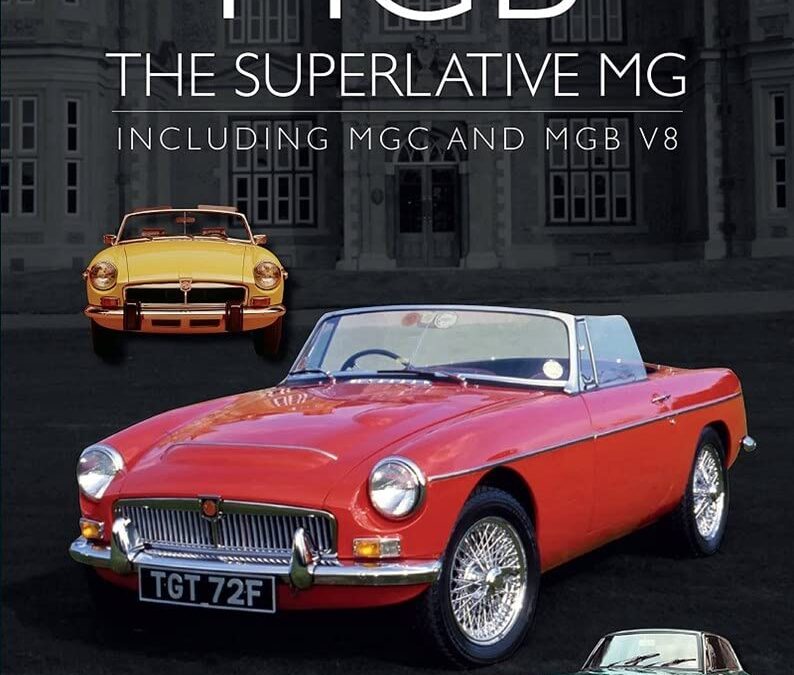
Launching in 1962 and in production for eighteen years, the MGB became one of the most successful sports cars the world has ever known. MGB – The Superlative MG describes how the MGB arose principally from the ideas of one man, MG’s Chief Engineer, Syd Enever, how it was designed and developed, how it survived and thrived, and how it became the classic car still so highly regarded today. With over 620 archive and specially commissioned photographs, including previously unseen models, sketches and prototypes, and packed with tables and data, it includes how the drive to replace the revolutionary MGA led to the development of the MGB, with the key personnel involved at each stage. It goes on to describe the genesis of the Pininfarina-refined MGB GT, and the Ferranti MGB hardtop as well as the MGC and incredible lightweight MGC GTS – including, for the first time, what became of the factory cars when first sold. The story of Ken Costello and his MGB V8, and the factory MGB GT V8 is covered along with the evolution of the MGB through the difficult period of British Leyland to the tragic end of the Abingdon factory. The full story of the lost cause of the Aston Martin Lagonda bid to rescue Abingdon and the MGB – including political and commercial insight is given along with detailed insight from many people who were closely involved in the creation, development and ultimate demise of the MGB. The motorsports story of the MGB family, including race details, insiders’ stories and key racer biographies is covered. Finally, the sales and marketing of the MGB in its two principal sales markets, including the clever advertising campaigns and commercials is covered and details of the overseas assembly of the MGB, in particular Ireland and Australia.

This book is unique. It not only tells you how carburetors work – but more importantly – why.
Carburetors, like many parts of a car, are not stand-alone devices. A carburetor’s “success” is highly dependent on many related components working together, just like the members of a football team must work together in order to win. We will discuss all aspects of the fuel and air systems of a gasoline engine from the gas tank until the air-fuel mixture enters the combustion chamber. To be able to effectively understand, diagnose and repair carburetors, it is important to understand all of these inter-related systems.
This book will complement the various service manuals you have for your cars. Some books have very good, detailed carburetor descriptions, while others are limited in the discussion of how the particular carburetor works. This book is not intended to replace these manuals, but to give you fundamental knowledge that will apply to virtually all carburetor designs. This book also includes more than just carburetor information, since it is the complete fuel, air, ignition and intake manifold systems that are important to fully understand your vehicle.
Over the past several years, I have been studying the Marvel carburetor calibrations on early Buicks and reporting the results in my “Early Buick and McLaughlin-Buick Owners” newsletter. The variation in air–fuel ratio (A/F) I observed on my 1916 and 1929 Buicks led me to do a more detailed analysis of intake manifold designs, which are critical to achieving an optimum carburetor calibration. It is interesting to see how both intake manifold designs and fuel delivery techniques evolved over the last 100 years.
In addition to my own antique cars, I have been involved in some interesting restorations of historically significant General Motor vehicles. I restored three carburetors used on the restoration of the GM Futurliner #10 and rebuilt the four side-draft carburetors used on the 1956X Buick concept car both restored by my good friend Don Mayton in Michigan. While both vehicles used standard production carburetors, the unique applications made them an interesting and rewarding experience.
The book discusses all aspects of the engine’s demand for air and fuel, how it is achieved and how engine designs affect carburetion. We will trace the carburetor’s evolution from the simple carburetors in the early 1900s, through the more complicated carburetors in the mid-1980s. We will see how emission regulations changed carburetors in the 1970s and 1980s, and ultimately led to electronically controlled fuel injection today. I will also use many analogies to help you understand the concepts in carburetors and fuel systems.
Enjoy and learn.
Dean G. Tryon



